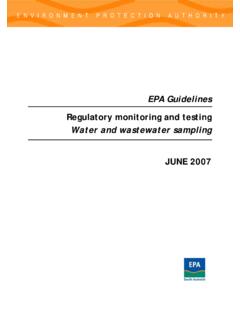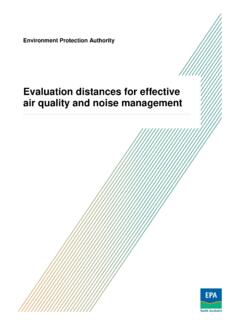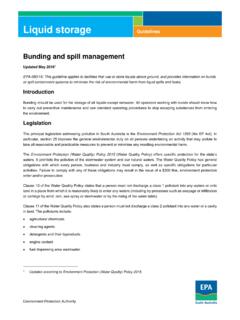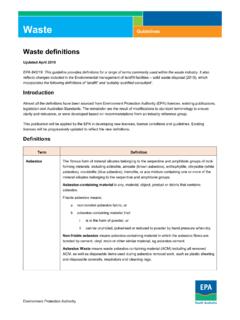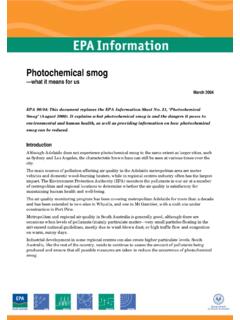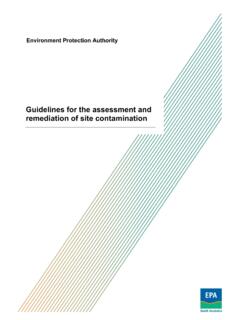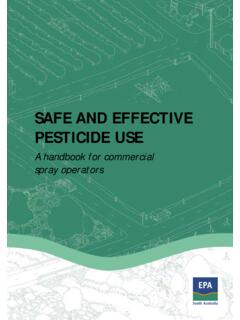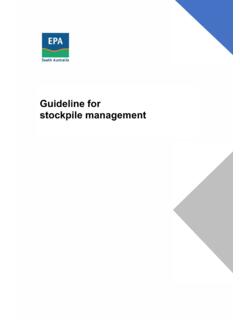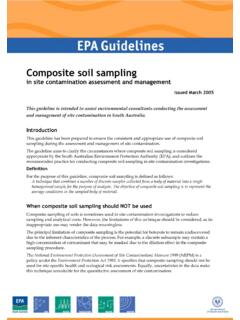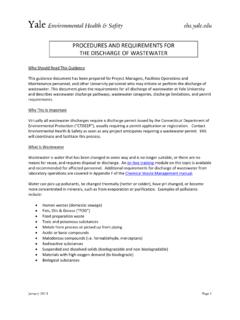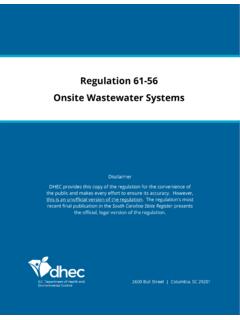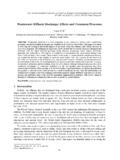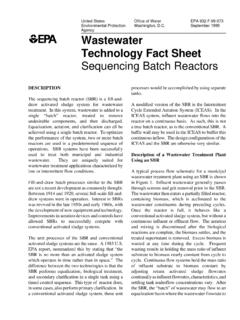Transcription of Wastewater lagoon construction guidelines
1 Environment Protection Authority Wastewater guidelines Wastewater lagoon construction Updated April 2019 EPA 509/19 : This guideline replaces Wastewater and evaporation lagoon construction (2004). It advises those proposing to build Wastewater lagoons on construction techniques that should assist in meeting obligations under the Environment Protection Act 1993 and relevant environment protection policies. The guideline is intended for Wastewater lagoon proponents and their engineers or consultants. This guideline is not intended for leachate lagoons for landfill facilities. For further guidance on the requirements for landfill facilities, refer to Environmental management of landfill facilities solid waste disposal.
2 Purposes of t he guideline The principal objectives of this guideline are to: safeguard the protected environmental values of surface or groundwater minimise the potential for site contamination provide clarity regarding criteria used for the assessment of Wastewater lagoon proposals assist Wastewater lagoon proponents in meeting the requirements of: the Environment Protection Act 1993 (the EP Act) and relevant environment protection policies (EPP). provide guidance on reasonable and practicable measures to prevent or minimise environmental harm resulting fromundertaking an activity that pollutes or might pollute waters (in compliance with the general environmental duty insection 25 of the EP Act).
3 The guideline will apply to new lagoon proposals and is not intended for lagoons that are already in place before the implementation of this guideline. Proponents who are upgrading existing lagoons should have regard to this guideline. A note on terminology: The term should is used where a particular course of action is considered by the EPA as best practice. The term must is used where a failure to comply with the action stated in the guideline will, in the EPA s view, exposethe environment to a risk of harm or may lead to a breach of the EP Act or relevant Wastewater lagoon construction Summary of engineering requirements to meet environmental obligations Proponents must.
4 1 obtain the relevant information in order to complete the risk assessment matrix provided in Appendix 1 2 be guided by the corresponding recommendations of Appendix 2 in developing a design for their Wastewater lagoon 3 demonstrate that the design and construction will ensure the ongoing integrity of the lagoon lining. By doing so, proponents and operators can demonstrate that all reasonable and practicable measures have been taken to prevent or minimise any resulting environmental harm to waters from their Wastewater lagoons in accordance with section 25 of the EP Act and relevant EPPs. The below is intended to summarise the key engineering requirements and reference pages within this document which provide further information, context and reading.
5 For all Wastewater lagoons: Lagoons must be designed and constructed so that Wastewater in the lagoon cannot intersect underlying seasonal water table. Lagoons must be designed and constructed so as not to be liable, as far as practicable, to or damage from flood waters. Lagoons must be designed and constructed to ensure that the contents of the lagoon do not (unless the overflow has been contemplated in the approved design and normal operation) into watersor onto land in a place from which they are reasonably likely to enter any waters. Lagoons must be constructed with an appropriate liner which achieves the required permeability criteria p.
6 9 and minimises leakage. The prepared subgrade must be proof-rolled to determine the presence of zones that may requirep. 9 subgrade improvement. The subgrade must be smooth and free of stones prior to geosynthetic linerplacement. Lagoons must be designed and constructed in accordance with appropriate leakage detectionp. lagoons with in-situ clay lining: An extensive investigation must be conducted by a geotechnical professional to confirm the efficiency p. 9 of this barrier. For lagoons with constructed clay-lining: The compacted clay liner must have a minimum thickness of 300 mm and be constructed in two layers of p.
7 10150 mm following compaction with an in-situ coefficient of permeability of less than 1 x 10-9 The finished liner thickness must be surveyed to confirm it meets the design specifications and be tested p. 10in-situ to ensure that it meets the specified permeability criteria (AS:1289 ).For lagoons with geosynthetic lining: A layer of the geosynthetic liner must be anchored (in accordance with manufacturers guidelines ) top. 11cover the entire floor and all sloping sides of the lagoon . All welded joints and seals must be watertight. Geomembranes must be free of blisters and contaminants. p. 11 Geosynthetic linersmust be laid in accordance with manufacturer s 11 Geomembranes must be assessed for liner integrity.
8 Geoelectric testing through a liner integrityp. 11survey assessment (LISA) is lagoon construction3 GCLs must be confined by at least 6 8 kpa. This pressure can be achieved by applying a minimump. 11300 mm of non-dispersive fine grained soil which will confine a swelling GCL when it becomes hydrated Appropriate thickness of geomembrane liner must be determined by the proponent s engineer/consultant p. 11based on Wastewater characteristics, groundwater/aquifer characteristics, climatic factors and warrantyconsiderationsIntroduction Wastewater1 management is an inherent aspect of many industrial operations. Wastewater from sewage treatment facilities, food , beverage and agricultural processing activities, and effluent from animal husbandry activities also contain valuable nutrients that are beneficial for crop production.
9 The EPA advocates the waste management hierarchy and recognises the importance of recycled water as an alternative water supply. For this reason, the EPA supports the reuse of treated Wastewater provided it is undertaken in a sustainable manner. Lagoons (or ponds) have been used extensively in the past to collect, naturally treat, store (prior to reuse or discharge) or dispose of Wastewater via evaporation. The uses and applications of these lagoons have increased in recent times. However, poorly constructed lagoons can lead to surface and groundwater pollution as well as odour and health impacts. This document provides basic guidance on the siting, construction and lining of Wastewater lagoons.
10 It covers the types of lagoons which, treat or store water with a higher concentration of pollutants, are constructed for the purpose of treating a waste stream, or represent a significant risk to the environment, including; Wastewater treatment, recycled water storage, polishing and evaporation lagoons used in sewage treatment facilities; food , beverage and agricultural processing industries; animal husbandry activities; and aquaculture purposes Wastewater sedimentation basins, leachate ponds for composting activities, irrigation dams used for holding andmixing treated or untreated Wastewater , and ponds on industrial sites used for capturing potentially contaminatedstormwater runoff from their premises processing and Wastewater lagoons for chemical, manufacturing and mining industries2 lagoons used for digestion, dewatering and drying Wastewater and water treatment term Wastewater lagoon will be used collectively in this document to refer to all of the above.
